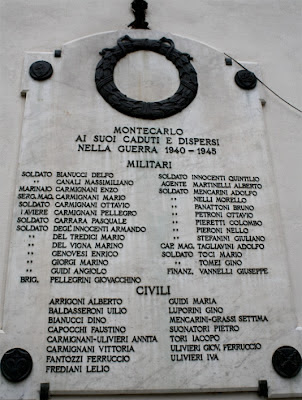 |
| This nuraghe (tower) has lost its top. It was once about twice this height. |
Friday, April 28
Most of the week, we have been enjoying dolce far niente—reading,
walking or lying on the beach, sitting on the deck, browsing through the street
markets, people-watching in piazze. Today we decide to take a short history
lesson, and we drive to a nuraghe to find out more about the prehistoric tribes
that populated Sardegna.
 |
| Inside the tholos, the top is thicker and the opening narrows. |
A nuraghe is a tower in a middle of a community center of a
civilization that had its roots here as early as 1800 BC. A nuragic village
served as a fortress, city hall, center of trade and dwelling place for the
tribal leaders. The people who built them are referred to as the nuragic
civilization, taken from the name of their primary structures, and there are
between 7,000 and 8,000 nuraghi in Sardegna, one for every three square
kilometers.
The nuragic village we visit, La Prisciona, was largely
buried by the natural forces of wind, dust, decay and erosion, but careful
excavation in recent years has uncovered some of its treasures. Our guide,
Ornella, tells us that the heart of the village is a naraghe, a conical tower.
La Prisgiona has one eight-meter tower left, but in ancient times, it had two,
and they were probably about 40 feet tall.
Many nuragic villages have more towers than La Prisciona
did. On the outside, the tower walls are pretty much vertical, but inside they
widen at the top, making the opening smaller and smaller. This is called a tholos,
or false dome, because from inside, it has the appearance of a dome, but it can
still stand without the top being closed completely to support the wall
structure. Between the outer wall and inner wall, there was a winding stone staircase,
but in La Priscione, it has partly caved in and is no longer passable.
 |
| This 1000 BC bronze Nuragic statue may give an idea of what a more elaborate naraghe looked like. |
Outside the tower, Ornella shows us an ancient well, which
still has fresh water in the bottom. Many pottery vases have been retrieved
from the well and are now displayed in a museum in Sassari. Some were very
plain and were used to draw water out, but others were ornate and may have been
thrown into the well as part of some kind of ritual, she says.
Other round rooms outside the tower were likely workshops
for potters, tool makers and other craftsmen, Ornella says. This opinion is
based on the various fragments found buried on the floors. Perhaps as many as
100 other huts are still buried in the four hectares surrounding La Priscione,
and these will be excavated in the coming years. Many were probably homes.
Not far from the nuraghe is another tomb of the giants,
bigger than the one we explored on Monday. The island is also dotted with these
tombs, since all the villages had to have burial sites. The nuragic people
dominated Sardegna until they were defeated by the Carthaginians around 500 BC
and forced to take refuge in the mountainous interior. The Carthaginians were
defeated in turn by the Romans, and Sardegna became a Roman province. The nuragic
civilization still maintained a separate identity until around 200 AD.
.jpg) |
| This is another Nuragic village, Barumini, and it gives some idea of what archaeologists may find when they finish excavating La Prisciona. |
Once back in our room, I look up more information and find
that these people have fascinated and baffled historians for many years. According
to Massimo Pallottino, a scholar of Sardinian prehistory, the architecture
produced by the Nuragic civilization was the most advanced of any
civilization in the western Mediterranean during this epoch, including those in
the regions of Magna Graecia.
It is surmised that the nuragic people were organized in
clans led by a chief. Many bronze art figures have been found, and from these it
is guessed that religion and warfare had a strong role in the society. They raised
crops and animals and were fishermen and traders. Since Sardegna has remained
relatively undeveloped in comparison with the rest of Italy, most of the
nuraghe remain undisturbed. Only a handful of the 7,000-plus nuraghi have been
scientifically excavated, so we can look forward to more of the mysteries about
this ancient culture to be revealed in coming years.
 |
| Bronze figures reveal much about the once powerful Nuragic civilization, which had advanced armies and boats that may have once dominated the Mediterranean. |









































